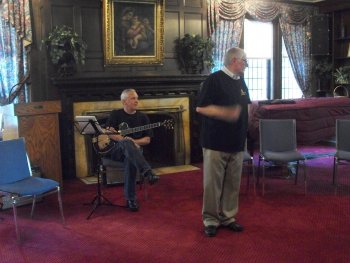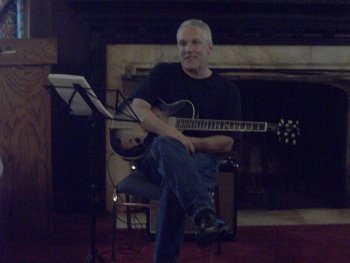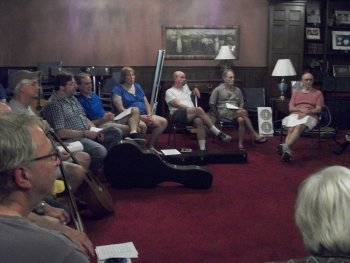“All You Ever Wanted to Learn About Jazz Guitar and More” ~ an RGC Presentation by Jon Greeno, August 17, 2015

Jon Greeno, graduate of the Berklee College of Music in Boston, Massachusetts brought his knowledge, experience and tricks of the trade to the Rochester Guitar Club on Monday, August 17. But, as Jon told us, ”No one really knows everything about jazz guitar, and if they did it couldn’t be told in two hours!”
All music, including jazz, consists of melody, rhythm and timbre. What makes jazz stand out from other genres is the element of improvisation. Jazz pieces are not usually played strictly as written as are other types of music. This means that big band music, like classical, is not strictly “jazz,” since the parts are written for the most part. Of course, big band has jazz elements, including designated sections for solo improvisations. On the other hand, there are other genres of music such as Indian consisting mostly of improvisation; yet they don’t sound like Western jazz. What all jazz has, though, is “swing” or “groove”. It is very much a “feel” kind of music.
The jazz musician will vary the basic elements in unexpected ways providing interest for the listener. Improvisation can be a change in tempo or any of the other elements of music. Often, the improviser creates new music within a structure of chord patterns or other identifying guidelines. However, “chord changes” are not absolutely required; Miles Davis was known to have sometimes comped on a single chord during the 1960’s. Soloists typically vary their techniques within an improvised piece as well. For instance, Wes Montgomery would play single note lines through a set of changes, then pluck octaves through a set, and then use full chords through another set.

Jazz swings, but the swing is in the groove when all the players are listening to each other and contributing their own ideas to the music as they spontaneously anticipate what is going to happen next. All this, of course, is based on technical principles that all the players understand and have internalized. Jon went into great detail about the technical aspects of jazz discussing the basic 1-5-1 chord progressions with variations such as 1-4-5-1 and discussed the concept of introducing 2-5 patterns within existing changes, leading to the “5 of 5” concept. This is essentially approaching any chord by using the dominant (5) as a preface. For example, a chord pattern of C, Am, F, G becomes C, Am, F, D7, G (the D7 being the dominant of the G... a 5 of 5). The most common application of this is known as “rhythm changes” (from the classic “I Got Rhythm” - the verse is a standard 1-6-2-5 and the bridge is a series of dominant chords: in C this is C, Am, Dm, G (verse) then E7, A7, D7, G7 (bridge).
This led to a discussion of chord substitution, specifically changing minor7 chords to dominant7 and the concept of tritone substitution. Because they share common defining notes, a dominant chord can be replaced by a dominant (or even Major7, for the daring) chord that is a tritone (3 whole steps) away. For example, C, Am, Dm, G becomes C, Am, Dm Db7 — the Db is a tritone away from G, but both chords are defined by the inner notes B and F (tritones in themselves!) and will resolve to C.
Much of what the jazz guitarist plays depends on whom he is playing with. He could be soloing or comping chords behind other players. Or the guitarist may avoid the lowest range of notes letting the bassist of the group do the “heavy lifting.” Similarly, if a pianist is present, you should follow his/her lead. Follow the chord changes, but be ready to make substitutions such as using the tritone for the dominant, or use diminished chords and added ninths and sixths. Always be aware of movable patterns. If two guitarists are in the group, each should play the same chords in different positions creating different timbres. Always support the leader or singer and fit in with the group. Use creative, expressive technique without getting in the way. Above all, listen, listen, listen to the other players in the group. Don’t be afraid to learn to play by playing. However, on the gig, don’t practice...just play.

Jon also emphasized the importance of melody. If a player doesn’t know the melody, any improvisation played likely won’t relate to it. Another suggestion is to “breathe” (pause) like a horn player. [Ed. Note: Many guitarists (Robben Ford, for example) listen to horn players for musical ideas.] Jon also stressed the importance of “playing the tune” vs. playing the person who played the song. In other words, don’t try to be Thelonius Monk!
The guitarists present had many questions for Jon, one of them being about alternate tunings. Jon does not use alternate tuning although he has tried random tuning, but with little success; standard tuning is challenging enough! He was once asked in a workshop why he wanted to play guitar. This is something for all of us to think about. There are many advantages to the guitar: versatility, affordability, variety of instruments, portability, comfort and significantly it is held close to the heart.
During his presentation Jon used several popular standards such as “Heart and Soul,” “Autumn Leaves” and “Misty.” These songs are still popular because their melodies are memorable and they consistently reveal new elements whenever they are played. He closed an informative and entertaining evening with a beautiful rendition of “Autumn Leaves” with John Williamson supporting him on bass guitar.
~Richard Taglieri/John Williamson
Photos: Richard Taglieri
Share this page: ![]() Facebook
Facebook
![]() Del.icio.us
Del.icio.us
![]() StumbleUpon
StumbleUpon
![]() Digg
Digg
![]() Reddit
Reddit
Home ::
About Us ::
Events ::
Articles ::
Resources ::
Contact Us ::
Links
©2007-2012, Rochester Guitar Club, All Rights Reserved, This page last updated 2015-09-14 16:31:50
Website by Red Beagle Web Development.








